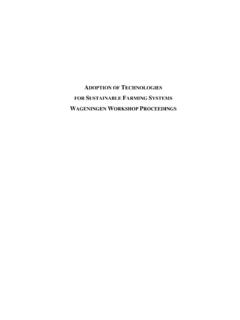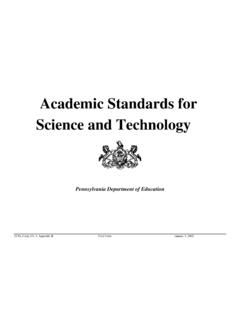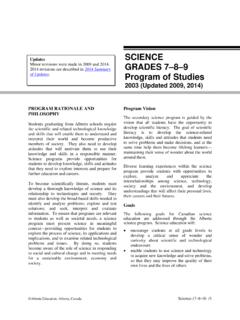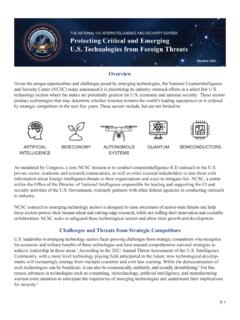Transcription of IB BIOLOGY SYLLABUS - BIOLOGY FOR LIFE
1 IB BIOLOGY SYLLABUS CORE: Topic 1: Cell BIOLOGY Topic 2: Molecular BIOLOGY Topic 3: Genetics Topic 4: Ecology Topic 5: Evolution and Biodiversity Topic 6: Human Physiology ADDITIONAL HIGHER LEVEL: Topic 7: Nucleic Acids Topic 8: Metabolism, Cell Respiration & Photosynthesis Topic 9: Plant BIOLOGY Topic 10: Genetics and Evolution Topic 11: Animal Physiology OPTIONS: schools can pick which option topic to cover. At SHS we have traditionally further Human Physiology (D) option. Even though called an option, this topic is not optional to learn. Option A: Neurobiology and behavior Option B: biotechnology and Bioinformatics Option C: Ecology and Conservation Option D: Human Physiology The IB BIOLOGY SYLLABUS is a list of all the understandings, applications and skills that the IB Organization mandates are taught throughout the two years of the IB BIOLOGY higher level course.
2 While we will not necessarily progress through the SYLLABUS statements in order, they are presented in order to you here. Note: the numbering of the understandings, applications and skills is utilized by SHS for organization, and is not a component of the IB BIOLOGY SYLLABUS as provided by the IBO. Topic 1: Cell BIOLOGY Introduction to Cells Essential Idea: The evolution of multicellular organisms allowed for cell specialization and cell replacement. U 1 Living organisms are composed of cells. U 2 Unicellular organisms carry out all functions of life. U 3 Cell Surface to volume is an important limitation to cell size. U 4 Multicellular organisms have properties that emerge due to the interaction of their cellular components. U 5 Specialized tissues can develop by cell differentiation in multicellular organisms.
3 U 6 Differentiation involves the expressions of some genes and not others in a cell s genome. U 7 The capacity of stem cells to divide and differentiate along different pathways is necessary in embryonic development and also makes stem cells suitable for therapeutic uses. A 1 Questioning the cell theory using atypical examples, including striated muscle, giant algae and aseptate fungal hyphae. A 2 Investigation of functions of life in Paramecium and one named photosynthetic unicellular organism. A 3 Use of stem cells to treat Stargardt s disease and one other named condition. A 4 Ethics of the therapeutic use of stem cells from specially created embryos, from the umbilical cord blood of a new-born baby and from an adult s own tissues. S 1 Use of a light microscope to investigate the structure of cells and tissues, with drawing of cells.
4 Calculation of the magnification of drawings and the actual size of structures and ultrastructures shown in drawings or micrographs. (Practical 1) NOS 1 Looking for trends and discrepancies- although most organisms conform to cell theory, there are exceptions. NOS 2 Ethical implications of research- research involving stem cells is growing in importance and raises ethical issues. Ultrastructure of Cells Essential Idea: Eukaryotes have a much more complex cell structure than prokaryotes. U 1 Prokaryotes have a simple cell structure without compartmentalization. U 2 Eukaryotes have a compartmentalized cell structure. U 3 Electron microscopes have a much higher resolution than light microscopes. A 1 Structure and function of organelles within exocrine gland cells of the pancreas and within palisade mesophyll cells U understanding specific content concepts A application illustrative examples or significant experiments in BIOLOGY history S skill practical activities or data analysis NOS nature of science the methods and limitations of BIOLOGY as a scientific endeavor of the leaf.
5 A 2 Prokaryotes divide by binary fission. S 1 Drawings of the ultrastructure of prokaryotic cells based on electron micrographs. S 2 Drawings of the ultrastructure of eukaryotic cells based on electron micrographs. S 3 Interpretations of electron micrographs to identify organelles and deduce the function of specialized cells. NOS 1 Developments in scientific research follows improvements in apparatus- the invention of the electron microscopes led to greater understanding of cell structure. Membrane Structure Essential Idea: The structure of biological membranes makes them fluid and dynamic. U 1 Phospholipids form bilayers in water due to the amphipathic properties of phospholipid molecules. U 2 Membrane proteins are diverse in terms of structure, position in the membranes and function.
6 U 3 Cholesterol is a component of animal cell membranes. A 1 Cholesterol in mammalian membranes reduces membrane fluidity and permeability to some solutes. S 1 Drawing of the fluid mosaic model. S 2 Analysis of evidence from electron microscopy that led to the proposal of the Davidson-Danielli model. S 3 Analysis of the falsification of the Davison-Danielli model that led to the Singer-Nicolson model. NOS 1 Using models as representations of the real world-there are alternative models of membrane structures. NOS 2 Falsification of theories with one theory being superseded by another-evidence falsified the Davison-Danielli model. Membrane Transport Essential Idea: Membranes control the composition of cells by active and passive transport. U 1 Particles move across membranes by simple diffusion, facilitated diffusion, osmosis and active transport.
7 U 2 The fluidity of membranes allows materials to be taken into cells by endocytosis or released by exocytosis. Vesicles move materials within cells. A 1 Structure and function of the sodium-potassium pumps for active transport and potassium channels for facilitated diffusion in axons. A 2 Tissues or organs to be used in medical procedures must be bathed in a solution with the same osmolarity as the cytoplasm to prevent osmosis. S 1 Estimation of osmolarity in tissues by bathing samples in hypotonic and hypertonic solutions. (Practical 2) NOS 1 Experimental design- accurate quantitative measurements in osmosis experiments are essential. Origin of Cells Essential Idea: There is an unbroken chain of life from the first cells on Earth to all cells in organisms alive today.
8 U 1 Cells can only be formed by division of pre-existing cells. U 2 The first cells must have arisen from non-living material. U 3 The origin of eukaryotic cells can be explained by the endosymbiotic theory. A 1 Evidence from Pastuer s experiments that spontaneous generation of cells and organisms does not now occur on Earth. NOS 1 Testing the general principles that underline the natural world- the principles that cells only come from pre-existing cells needs to be verified. Cell Division Essential Idea: Cell division is essential but must be controlled. U 1 Mitosis is division of the nucleus into two genetically identical daughter nuclei. U 2 Chromosomes condense by supercoiling during mitosis. U 3 Cytokinesis occurs after mitosis and is different in plants and animal cells.
9 U 4 Interphase is a very active phase of the cell cycle with many processes occurring in the nucleus and cytoplasm. U 5 Cyclins are involved in the control of the cell cycle. U 6 Mutagens, oncogenes and metastasis are involved in the development of primary and secondary tumors. A 1 The correlation between smoking and incidence of cancers. S 1 Identification of phases of mitosis in cells viewed with a microscope or in a micrograph. S 2 Determination of a mitotic index from a micrograph. NOS 1 Serendipity and scientific discoveries- the discoveries of cyclins was accidental. Topic 2: Molecular BIOLOGY Molecules to Metabolism Essential Idea: Living Organisms control their composition by complex web of chemical reactions. U 1 Molecular BIOLOGY explains living processes in terms of the chemical substances involved U 2 Carbon atoms can form four covalent bonds allowing a diversity of stable compounds to exist U 3 Life is based on carbon compounds including carbohydrates.
10 Lipids proteins and nucleic acids U 4 Metabolism is the web of all the enzyme-catalyzed reactions in a cell or organism U 5 Anabolism is the synthesis of complex molecules from simpler molecules including the formation of macromolecules from monomers by condensation reactions U 6 Catabolism is the breakdown of complex molecules into simpler molecules including the hydrolysis of macromolecules into monomers A 1 Urea as an example of a compound that is produced by living organisms but can also be artificially synthesized S 1 Drawing molecular diagrams of glucose, ribose, a saturated fatty acid and a generalized amino acid S 2 Identification of biochemical such as sugars, lipids, or amino acids from molecular drawings NOS 1 Falsification of theories- the artificial synthesis of urea helped to falsify vitalism.







